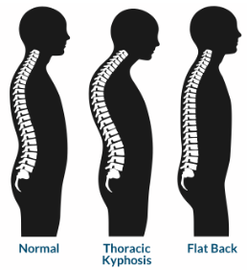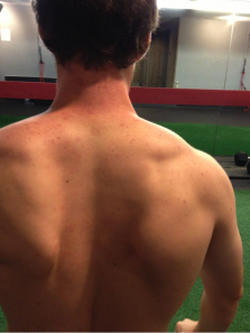Typically, when we think about improving our posture we think of this:


While exercises geared toward opening up the chest and extending the back work great for many people, in some instances it can actually make things worse. Especially in athletes and those under 40. One of the biggest misconceptions out there is that everyone is stiff, everyone is a hunchback, and everyone has a lazy rounded mid-back (thoracic spine). If this sounds like you, and now you’ve just sat up a little bit straighter because you read the word posture: I’m here to give you some solid info about posture, how it can be so different from person to person, and some easy ways to correct it based on your spine!
So, what are these differences? First, this part of the spine has the most variation from person regarding the resting curve. Here are the main 3 types:

A “normal” thoracic spine is supposed to have a mild kyphotic (or rounded) curve. What we actually see is that about half the population has a normal or excessively kyphotic curve, and the other half is actually excessively flat. Just like being too kyphotic and rounded, being excessively flat isn’t good either (AND is addressed completely differently).
Let’s first start discussing the excessive kyphotic curve. If you have more of the stiff rounded upper back, then the traditional posture correction recommendations are for you! These include for sitting: the feet being flat, hips to the back of the chair, utilizing the back of the chair for support but maintaining an upright position, elbows supported and at your sides, and the top of the computer screen being at eye level. You can also utilize the exercises below to increase thoracic extension and rotation to improve the upright posture!
Now, here’s where things take a turn.
The other half of the population, which typically includes the majority of the younger and more athletic people, have a very flat thoracic spine. A flat thoracic spine results in a loss of normal kyphotic curvature. To connect the dots back to posture… while sitting with a naturally flat thoracic spine, when you actively sit up straighter and pull your shoulder blades back you are taking your spine further away from a normal resting curvature!

The flat thoracic spine (that is worsened by you trying to sit up even straighter) is problematic because of its role as the foundation for the shoulder blades (Scapula) and neck. Based on the photo to the left, you can see he has decent muscle bulk around the spine but the spine itself is incredibly flat.
When you lack the correct curvature of the thoracic spine, the muscles in charge of supporting the neck are given the impossible task of keeping the head in the correct position. In this case, the neck muscles end up overworked and it causes the head to start falling forward. If you think about holding a bowling ball, you could hold it a lot longer if it’s close to your body right vs arm extended, right? Now imagine, holding the 16 pounder (yes, that’s close to the average weight of the head) with your arms all the way out straight – that’s not going to last too long! Holding the ball away from you is similar to what the small muscles of the neck are asked to do as the head drops forward!
As for the shoulder blades, they need a good foundation to rest on. With a flat thoracic spine, they tend to start dropping down the back like melting ice cream. This results in too much lengthening of the muscles connecting the neck and scapula, and if you’ve read our other blog “The Myth of “Upper Trap Tightness”: Is the Upper Trap the Devil?,” then you know that over lengthened muscles are weak and will become painful! So, while bad posture at times can cause pain directly, typically it sets up other areas for failure.
If you’re like me and over 80% of the people we treat, flat back posture correction looks a little different! We still want the hips to sit all the way back in the chair, but instead of forcing the back to stay upright, you’ll want to actually push your midback to the backrest into somewhat of a slouch that is still supported. You can see in the graphic above that he is leaning into the back of his chair and actually looks comfortable! Elbow position and computer screen recommendations remain the same! As far as exercises go, if you only use those from the 1st video above you’re moving yourself further into the problem! If you have a flat back, the video below is made just for you to focus on improving flexion and rotation to restore some of the natural kyphotic curve!
If you’re in need of sports physical therapy in Charlotte, NC, we woud love to help!
Thanks for reading!
Dr. Mike


5 Responses
Nice post. I learn something new and challenging on blogs I stumbleupon every day. Its always interesting to read content from other writers and use something from other web sites.
That is great to hear, thank you for reading!
Your home is valueble for me. Thanks!…
Hi! Someone in my Myspace group shared this website with us so I came to look it over. I’m definitely enjoying the information. I’m book-marking and will be tweeting this to my followers! Exceptional blog and fantastic design and style.
A fascinating discussion is worth comment. I think that you need to
write more about this subject matter, it might not be a taboo subject but typically
people do not talk about these issues. To the next!
All the best!!